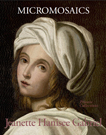| |
Micromosaics - Private Collections
One of the principal pleasures offered by mosaics is enjoying the way they are made from individual pieces of glass or stone, maybe a half-inch or quarter-inch in size, and the way these tesserae flow within the mosaic, the patterns they embody - what mosaicists call the andamento. True micromosaics (i.e. 18th to 19th century) are generally speaking the exact opposite; the tesserae are virtually invisible (sometimes the width of a needle) and the wonder then is how on earth was it done? And why? Why not use paint? Much less painstaking.
Well it all began with a pope. Urban VIII to be precise (reigned 1623-1644). The people running St. Peterís had noticed that the paintings in the cathedral were fading and peeling, whereas the existing mosaics were still pristine. So the order went out from on high that the paintings should be replaced by mosaic copies. The first was St. Michael by Giovan Battista Calandra in 1629. But this and the others of the period were still standard mosaics.
The first mosaic in St. Peterís to be made with smalti filati, glass heated and then drawn out till as narrow as a thread, was the Navicella altarpiece by Pietro Paolo Cristofari, in 1727. The tesserae were so tiny that you couldnít tell the painting was a mosaic. Micromosaics were born, though the term was actually invented by the great collector Sir Arthur Gilbert in the 20th century.
Jeanette Gabriel has previously written the definitive study of the micromosaics in Sir Arthurís sumptuous collection at the Victoria and Albert Museum, London ("Micromosaics - Gilbert Collection, Philip Wilson 2000"). And now she has written the definitive study of micromosaics in private hands.
Naturally if you were going to make mosaics closely resemble paintings you had to have a huge range of colours, and the tesserae needed to be non-reflective. Happily, by the mid-eighteenth century the Vatican workshop, under Alessio Mattioli, had come up with some 28,000 shades no less.
By the late eighteenth century a few Roman mosaicists had started making miniature mosaics, and the craft, or was it art?, flourished from then on. The Introduction to Gabrielís book includes a fascinating 19th century account of how micromosaics were made, and goes on to survey the whole field up to the early 20th century, when the era of fine micromosaics ended.
The meat of the book is devoted to superb photos and studies of individual micromosaic masterpieces now in private collections, arranged in various categories: tables, pictures, plaques, boxes, jewellery and miscellaneous (paperweights and caskets). Each is catalogued by place of origin, mosaicist (where known), measurements, provenance, and each has an article about the mosaic and its history to date.
The lengthy Appendix offers several outstanding features, starting with a detailed biography of the splendidly-named Michelangelo Barberi, "perhaps the greatest micromosaic artist in history". Among his achievements was a long-term love affair with a Russian princess, Zinaida Volkonsky, a gifted singer who also had an affair with the Emperor Alexander I - Tolstoy, eat your heart out. Cela va sans dire that Michelangelo made a magnificent micromosaic portrait of Alexander.
There are also listings of micromosaics in the Hermitage Museum in St. Petersburg and of some Demidoff mosaics, plus biographies and a list of documented mosaicists, and four illustrated pages of stolen mosaics, so keep your eyes peeled.
By no means least thereís a warning that widely available miniature mosaics made of small unpolished glass pieces and costing a few pounds or dollars are no way the same as genuine 18th and 19th century antiques made of polished, opaque, enamel tesserae. The real thing would cost you thousands. So if you havenít got that sort of cash and you love micromosaics you would be well advised to invest in this superlative volume.
Paul Bentley
TO BUY A COPY VISIT www.micro-mosaic.com or in UK DonKellybooks@btinternet.com
Price: in UK £89.50 & pp £4.48. In USA $125 |




